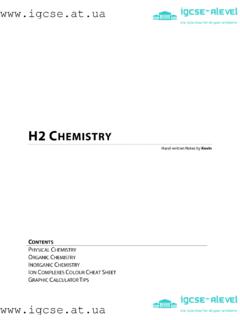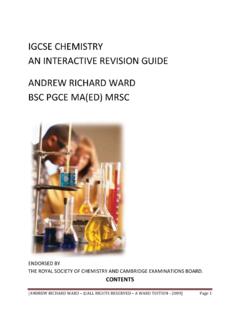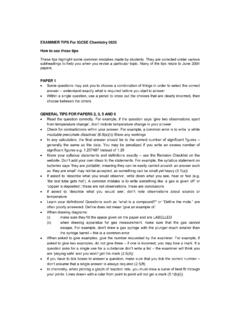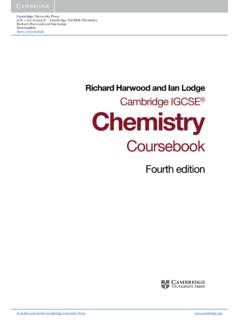Transcription of ORGANIC CHEMISTRY - igcse.at.ua
1 CHEMISTRY OIL and its many useful PRODUCTS The origin of oil Crude oil is formed from ORGANIC material of the remains of plant and animal organisms that lived millions of years ago. These remains form sediments eg at the bottom of seas, and become buried under layers of sedimentary rock. They decay, without air (oxygen), under the action of heat and pressure to form crude oil over millions of years. It is a fossil fuel because it is formed from once living organisms and the Sun is the original source of energy. It is a non-renewable and finite (limited reserves) energy resource because it takes millions of years to form and we burn it faster than its is formed!
2 It is also known as a finite energy resource because it will eventually run out! We do not have unlimited oil reserves! Coal and natural gas (mainly methane CH4 and often found with oil) are also non-renewable fossil fuels formed from the remains of plants or animals. When the fossil fuels are burned the 'carbon', as carbon dioxide, is returned to the living environment, gets used up in photosynthesis, the plant material decays or is eaten by animals, so completing the carbon cycle. The SEPARATION of the crude oil mixture into fractions and the USES of these fractions A fraction is a mixture of a restricted boiling point range of molecules, they have a similar number of carbon atoms and physical properties.
3 The uses of the fractions depend on their physical and chemical properties. 2 Hydrocarbon molecules are only made of a chemical combination of carbon and hydrogen atoms. They are compounds because they consist of atoms of atleast two different elements. Crude oil is a complex mixture of mainly hydrocarbon compound molecules. A mixture consists of two or more elements or compounds which are not chemically combined. The chemical properties of each substance in the mixture is unchanged. This means crude oil can be separated by physical methods, in this case fractional distillation, because they have different boiling and condensation points.
4 The most volatile fraction, ie with the lowest boiling point, boils or evaporates off first and goes to the top of the column. The rest separate out according to their boiling point so that the highest boiling fraction, ie the less volatile with higher boiling points, tend to condense more easily lower down the column. The bigger the molecule, the greater the intermolecular forces, so the higher the boiling point. Chemical bonds are not broken in the process, only the intermolecular force of attraction. THE FRACTIONAL DISTILLATION OF CRUDE OIL names of fractions C atoms in the molecule boiling range in oC USES of the fraction Fuel Gas, LPG, Refinery Gas 1 to 4 -160 to 20oC methane gas fuel, C3-4 easily liquefied, portable energy source bottled gas for cooking (butane), higher pressure cylinders (propane)
5 Gasoline, Petrol 5 to 11 20 to 60oC easily vaporised, highly flammable, easily ignited, car fuel Naphtha 7 to 13 60 to 180oC no good as a fuel, but valuable source of ORGANIC molecules to make other things, cracked to make more petrol and alkenes Paraffin, Kerosene 10 to 16 120 to 240oC less flammable than petrol, domestic heater fuel, jet fuel Diesel oil, Gas oil 15 to 25 220 to 250oC Car and larger vehicle fuel Fuel and lubricating Oils and Waxes 20 to 70 250 to 350oC not so easily evaporated, not as flammable, safe to store for central heating oil, quite viscous (sticky)
6 And can also be used for lubricating oils, clear waxes and polishes Bitumen over 70 over 350oC forms a thick, black, tough and resistant adhesive on cooling, used as waterproofing material and to sticks rock chips on roofs or road surfaces 3 More on examples of relating the physical properties of the fractions to their uses and dangers down the list the molecule gets bigger, more viscous, higher boiling and less flammable The refinery gas fractions, under pressure, are conveniently pumped to burner systems, but are easily ignited and explosive.
7 Vehicle fuels must be liquid for compact and convenient storage but they must be easily vapourised to mix with air in the engine prior to ignition. The ease of vaporisation does however make them flammable! Paraffin and kerosine are less flammable and safer, but not as easily ignited. Fuel oil is not too viscous to pump to a central heating burner, and it is not very volatile and so not as flammable and dangerous as petrol or diesel etc. for domestic use. Lubricating oil must be quite viscous to stick onto surfaces. Smaller molecules might be more runny but they would evaporate away!
8 It is also water repellent and helps reduce corrosion on moving machine parts. Candle wax is very convenient as a solid for humble lamp (especially in power cuts!), but via a wick, the heat from the flame is sufficient to vaporise the hydrocarbons to burn them. Bitumen is a water repellent solid at room temperature but is readily melted (sometimes too easily in hot weather). Used as base for a road chipping top surface or sometimes directly. It is also used to waterproof roofing felt. 4 5 The ALKANE series of hydrocarbons Alkanes are a group of hydrocarbon molecules in which all the carbon and hydrogen atoms are only joined by single covalent bonds (eg C-H or C-C).
9 Alkanes are known as saturated molecules because other atoms cannot add to them (compare alkenes further on). The first four in the series are shown. They are not very reactive unless burned! (1) is the molecular formula: a summary of the totals of each atoms of each element in one molecule; (2) is a 'shorthand' version of the structural formula (3); (3) is called the structural formula: it shows how all the atoms are linked with the covalent bonds -; (4) is a '3D' representation of the structural formula (3) (1), (3), (4) methane (main molecule in natural gas) (1) (2) (3) (4) ethane (1) (2) (3) propane (1) (2) (3) butane 7 The complete combustion of hydrocarbons When hydrocarbons are burned in air a fast exothermic reaction occurs releasing heat and forming carbon dioxide and water.
10 It is an oxidation reaction due to O gain by C and H. The carbon dioxide is chemically detected with limewater - with which it forms a white precipitate (milky appearance) of calcium carbonate. The water is chemically detected either by (i) anhydrous white copper sulphate turning blue OR (ii) anhydrous blue cobalt chloride paper turning pink. A physical test for water is to measure its boiling point (should be 100oC). Equations for the complete combustion of a hydrocarbon hydrocarbon + oxygen => carbon dioxide + water eg word equation: methane + oxygen => carbon dioxide + water and the symbol equation: CH4(g) + 2O2(g) => CO2(g) + 2H2O(l) (one CO2 for every C and one H2O for every two H's in the hydrocarbon molecule) for ethane the symbol equation (more awkward) is.









